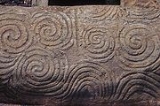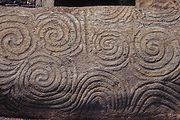
Megalithic art
Encyclopedia
Megalithic art refers to the use of large stones as an artistic medium. Although some modern artists and sculptors make use of large stones in their work, the term is more generally used to describe art carved onto megalith
s in prehistoric Europe
.
Megalithic art is found in many places in Western Europe
although the main concentrations are in Ireland
, Brittany
and Iberia
. Megalithic art started in the Neolithic
and continued into the Bronze Age
. Although many monument types received this form of art the majority is carved on Neolithic passage graves. Megalithic art tends to be highly abstract and contains relatively few representations of recognisable real objects. Megalithic art is often similar to prehistoric rock art
and contains many similar motifs such as the 'cup and ring mark
', although the two forms of rock carving also have large stylistic differences. The meaning of megalithic art is the subject of much debate.
Weathering
and vandalism have affected many examples of the art and little of it remains to day.

derived from induced states of altered consciousness
(Dronfield 1993). Stylistically the art of Ireland is similar to occasional finds in nearby Wales
and the Scottish Isles
.
at Gavrinis
and the Barnenez
mound.
. The gallery grave
at Züschen
in Germany
is an intriguing exception, as it appears to mix motifs known from the west European megalithic tradition with others more familiar from alpine Rock art
.
s of the Seine-Oise-Marne culture
such as that at Courjeonnet
have images of axes, breasts and necklaces carved on their walls. The meaning of some of these is disputed. For instance, some of the tombs in the valley of the Petit Morin
in France and elsewhere contain engravings of breasts, noses, hair, and a collar or necklace. These have been described both as deities (occasionally as 'dolmen deities') and as representations of the deceased.
Megalith
A megalith is a large stone that has been used to construct a structure or monument, either alone or together with other stones. Megalithic describes structures made of such large stones, utilizing an interlocking system without the use of mortar or cement.The word 'megalith' comes from the Ancient...
s in prehistoric Europe
Prehistoric Europe
Prehistoric Europe refers to the prehistorical period of Europe, usually taken to refer to human prehistory since the Lower Paleolithic, but in principle also extending to geological time scale - for which see Geological history of Europe....
.
Megalithic art is found in many places in Western Europe
Western Europe
Western Europe is a loose term for the collection of countries in the western most region of the European continents, though this definition is context-dependent and carries cultural and political connotations. One definition describes Western Europe as a geographic entity—the region lying in the...
although the main concentrations are in Ireland
Ireland
Ireland is an island to the northwest of continental Europe. It is the third-largest island in Europe and the twentieth-largest island on Earth...
, Brittany
Brittany
Brittany is a cultural and administrative region in the north-west of France. Previously a kingdom and then a duchy, Brittany was united to the Kingdom of France in 1532 as a province. Brittany has also been referred to as Less, Lesser or Little Britain...
and Iberia
Iberian Peninsula
The Iberian Peninsula , sometimes called Iberia, is located in the extreme southwest of Europe and includes the modern-day sovereign states of Spain, Portugal and Andorra, as well as the British Overseas Territory of Gibraltar...
. Megalithic art started in the Neolithic
Neolithic
The Neolithic Age, Era, or Period, or New Stone Age, was a period in the development of human technology, beginning about 9500 BC in some parts of the Middle East, and later in other parts of the world. It is traditionally considered as the last part of the Stone Age...
and continued into the Bronze Age
Bronze Age
The Bronze Age is a period characterized by the use of copper and its alloy bronze as the chief hard materials in the manufacture of some implements and weapons. Chronologically, it stands between the Stone Age and Iron Age...
. Although many monument types received this form of art the majority is carved on Neolithic passage graves. Megalithic art tends to be highly abstract and contains relatively few representations of recognisable real objects. Megalithic art is often similar to prehistoric rock art
Rock art
Rock art is a term used in archaeology for any human-made markings made on natural stone. They can be divided into:*Petroglyphs - carvings into stone surfaces*Pictographs - rock and cave paintings...
and contains many similar motifs such as the 'cup and ring mark
Cup and ring mark
Cup and ring marks or cup marks are a form of prehistoric art found mainly in Atlantic Europe and Mediterranean Europe although similar forms are also found throughout the world including Mexico, Brazil, Greece, and India, where...
', although the two forms of rock carving also have large stylistic differences. The meaning of megalithic art is the subject of much debate.
Weathering
Weathering
Weathering is the breaking down of rocks, soils and minerals as well as artificial materials through contact with the Earth's atmosphere, biota and waters...
and vandalism have affected many examples of the art and little of it remains to day.

Ireland
Ireland has the largest concentration of megalithic art in Europe, particularly in the Boyne Valley. This art form appears to be entirely abstract and is perhaps the most famous with its well known multiple-spirals. It is believed that much of this artwork is entopticallyEntoptic phenomena (archaeology)
For a medical definition please see Entoptic phenomenonIn archaeology, the term entoptic phenomena relates to visual experiences derived from within the eye or brain . In this respect they differ slightly from the medical definition, which defines entoptic phenomena as only applying to sources...
derived from induced states of altered consciousness
Altered state of consciousness
An altered state of consciousness , also named altered state of mind, is any condition which is significantly different from a normal waking beta wave state. The expression was used as early as 1966 by Arnold M. Ludwig and brought into common usage from 1969 by Charles Tart: it describes induced...
(Dronfield 1993). Stylistically the art of Ireland is similar to occasional finds in nearby Wales
Wales
Wales is a country that is part of the United Kingdom and the island of Great Britain, bordered by England to its east and the Atlantic Ocean and Irish Sea to its west. It has a population of three million, and a total area of 20,779 km²...
and the Scottish Isles
Scotland
Scotland is a country that is part of the United Kingdom. Occupying the northern third of the island of Great Britain, it shares a border with England to the south and is bounded by the North Sea to the east, the Atlantic Ocean to the north and west, and the North Channel and Irish Sea to the...
.
Brittany
Brittany has the second highest concentration of megalithic art. The earliest examples in this area are with anthropomorphic representations on menhirs which later continued in passage graves. Brittany shares some motifs with both Ireland and Iberia and the level of contact between them has always been debated. Among the most famous examples are the passage gravePassage grave
thumb|250px|right|A simple passage tomb in [[Carrowmore]] near [[Sligo]] in IrelandA passage grave or passage tomb consists of a narrow passage made of large stones and one or multiple burial chambers covered in earth or stone. Megaliths are usually used in the construction of passage tombs, which...
at Gavrinis
Gavrinis
Gavrinis is a small island, situated in the Gulf of Morbihan in Brittany, France. It contains the Gavrinis tomb, a megalithic monument notable for its abundance of megalithic art in the European Neolithic. Administratively, it is part of the commune of Larmor-Baden.-Geography:Reachable by boat...
and the Barnenez
Barnenez
The Cairn of Barnenez is a Neolithic monument located near Plouezoc'h, on the Kernéléhen peninsula in northern Finistère, Brittany...
mound.
Iberia
Iberian megalithic art contains the most number of realistic representations of objects, although there is also a strong abstract element. Iberia is the only place to have painted decoration as well as carved. Other areas may also have originally been painted, but Iberia's arid climate lends itself to preservation of the paint.The paint (as it currently survives) is normally restricted to black and red, although occasionally features white as well.Germany
Megalithic art is extremely rare in Central EuropeCentral Europe
Central Europe or alternatively Middle Europe is a region of the European continent lying between the variously defined areas of Eastern and Western Europe...
. The gallery grave
Gallery grave
A Gallery grave is a form of Megalithic tomb where there is no size difference between the burial chamber itself and the entrance passage. Two parallel walls of stone slabs were erected to form a corridor and covered with a line of capstones. The rectangular tomb was covered with a barrow or a cairn...
at Züschen
Züschen (megalithic tomb)
The Züschen tomb is a prehistoric burial monument, located between Lohne and Züschen, near Fritzlar, Hesse, Germany. Classified as a gallery grave or a Hessian-Westphalian stone cist , it is one of the most important megalithic monuments in Central Europe...
in Germany
Germany
Germany , officially the Federal Republic of Germany , is a federal parliamentary republic in Europe. The country consists of 16 states while the capital and largest city is Berlin. Germany covers an area of 357,021 km2 and has a largely temperate seasonal climate...
is an intriguing exception, as it appears to mix motifs known from the west European megalithic tradition with others more familiar from alpine Rock art
Rock art
Rock art is a term used in archaeology for any human-made markings made on natural stone. They can be divided into:*Petroglyphs - carvings into stone surfaces*Pictographs - rock and cave paintings...
.
Non-abstract art
As well as abstract or geometric art, some carvings are considered to represent tools, weapons, animals, human figures, deities or idols. The gallery graveGallery grave
A Gallery grave is a form of Megalithic tomb where there is no size difference between the burial chamber itself and the entrance passage. Two parallel walls of stone slabs were erected to form a corridor and covered with a line of capstones. The rectangular tomb was covered with a barrow or a cairn...
s of the Seine-Oise-Marne culture
Seine-Oise-Marne culture
The Seine-Oise-Marne or SOM culture is the name given by archaeologists to the final culture of the Neolithic and first culture of the Chalcolithic in northern France and southern Belgium....
such as that at Courjeonnet
Courjeonnet
Courjeonnet is a commune in the Marne department in north-eastern France....
have images of axes, breasts and necklaces carved on their walls. The meaning of some of these is disputed. For instance, some of the tombs in the valley of the Petit Morin
Petit Morin
The Petit Morin is a 86 km long river in France, left tributary of the Marne. Its source is in the commune Val-des-Marais. Its course crosses the departments of Marne, Aisne and Seine-et-Marne...
in France and elsewhere contain engravings of breasts, noses, hair, and a collar or necklace. These have been described both as deities (occasionally as 'dolmen deities') and as representations of the deceased.

